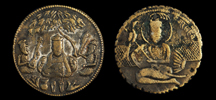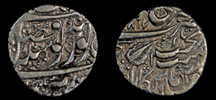|
|
The year 1799 marked a turning point in the history of Sikhs. In this year Ranjit Singh, obtained the grant of Lahore from Shah Zaman, the Durrani Ruler of Afghanistan. On 12th April 1801, Ranjit Singh was proclaimed Maharaja of Punjab . He had great ambitions to have a United Sikh Empire, he was able to enlarge his domains by occupying Amritsar, Multan, Kashmir and Derajat, Peshawar.
Maharaja Ranjit Singh died on 27th June, 1839, and his weak successor failed to control his empire. In 1845, the Sikh enemy lost the battle with British army. In 1848, the outbreak of 2nd Sikh War ended with the final defeat of Sikhs at Gujrat on 21st February, 1849. The abduction of the infant Maharaja Delip Singh and the annexation of Punjab on 29th March, 1849 marked the end of Sikh rule.
Sikh Coinage: Except few, all the identified Sikh mints had already worked under the Mughals and Afghans, including the denominations. Gold coins were issued in small numbers to be used as Nazranas, the Nanakshahis of Amritsar and silver rupees were the basis of their currency.
At Amritsar and Lahore, Sikh exercised a high degree of control over local copper coinage, Weight standard of Paisa was 11 mashas � (10g)
The beginning of Sikh coinage was from 1765 AD. In April 1765 the Sikh assembled at Akal Takht, founded the Sikh state and declared independence, also decided to mint coins in the name of Guru Nanak and Guru Gobind Singh. The first of these coins were rupees issued in VS 1822 (1765 AD) from Lahore, Amritsar followed in VS 1832 (1775 AD). Although retaining the weight standards of Mughals, its coins inscriptions were totally charged. For obverse there were two legends � each with several minor varieties � known as Nanakshahi and Gobindshahi couplet.
The Misl Coinage: After the death of most powerful leader, Jassa Singh Ahluwalia, in 1783 (VS 1840), different Misldars became practically independent. The rupees issued then � differ in marks, dating system and sometimes additional works but with same basic pattern and standard of Khalsa coins and JULUS AKAL TAKHT formula on reverse.
The Misl period came to close when Ranji Singh ousted Bhangis from Lahore in 1799 (VS 1856) and the Misl coinage came to an end after about 10 years.
Ranjit Singh continued the Nanakshahi type in Amritsar, which was introduced in VS 1845, but in VS 1858 uniform Amritsar Nanakshahi series splits into 3-4 parallel subseries differing in their Marks, these run for few years and then replaced by new ones, went on until VS1906.
All the regular Sikh rupees of north west India, bore Persian inscriptions, but the copper coins were also issued in Gurumukhi script, in addition to Persian
In the central parts of the Sikh domain the Nanakshai rupee was the predominant currency as well as an important weight unit. |
|
|


